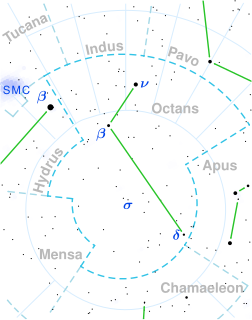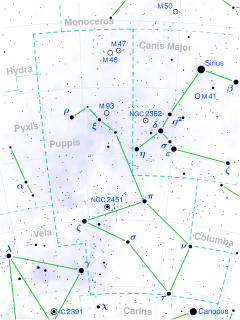
Rho1 Sagittarii, Latinized from ρ1 Sagittarii, is a single, variable star in the southern constellation of Sagittarius. It has a white hue and is visible to the naked eye with an apparent visual magnitude that fluctuates around 3.93. The distance to this star is approximately 127 light years based on parallax, and it is drifting further away with a radial velocity of +1.2 km/s. It is positioned near the ecliptic and so it can be occulted by the Moon.

67 Ophiuchi is a class B5 Ib star in the constellation Ophiuchus. Its apparent magnitude is 3.93 and it is approximately 1200 light years away based on parallax. It is considered to be a member of the open cluster Collinder 359.

68 Ophiuchi is a binary star system in the equatorial constellation of Ophiuchus. It is visible to the naked eye as a faint star with an apparent visual magnitude of 4.42. The system is located around 89.69 parsecs (292.5 ly) distant from the Sun, based on parallax, and is drifting further away with a radial velocity of +6 km/s.

γ Monocerotis, Latinised as Gamma Monocerotis, is a binary star system in the equatorial constellation of Monoceros. Based upon an annual parallax shift of 6.55 mas, it is located roughly 500 light years from the Sun. It can be viewed with the naked eye, having an apparent visual magnitude of 3.96. Gamma Monocerotis is moving away from the Sun with a radial velocity of −5 km/s.

ε Monocerotis, Latinised as Epsilon Monocerotis, is the Bayer designation of a binary star system in the equatorial constellation Monoceros. Its location is a guide for sky navigation toward the Rosette Nebula.

Epsilon Microscopii, Latinized from ε Microscopii, is a single, white-hued star in the southern constellationof Microscopium. It is faintly visible to the naked eye with an apparent visual magnitude of 4.71. The annual parallax shift of the star is 19.7054 mas as measured from Earth, which yields a distance estimate of around 166 light years. It is moving further from the Sun with a radial velocity of +7 km/s.
Zeta Monocerotis, Latinized from ζ Monocerotis, is a single, yellow-hued star in the constellation Monoceros. It has an apparent visual magnitude of 4.33, which is bright enough to be visible to the naked eye. The annual parallax shift as measured during the Hipparcos mission is 3.08 milliarcseconds, which provides a rough distance estimate of 1,060 light years. It is moving away from the Sun with a radial velocity of +30 km/s.

Beta Octantis, Latinized from β Octantis, is a probable astrometric binary star system in the southern circumpolar constellation of Octans. It is faintly visible to the naked eye with an apparent visual magnitude of 4.13. Based upon an annual parallax shift of 21.85 mas as seen from Earth, it is located about 149 light years from the Sun. It is moving away from the Sun with a radial velocity of +19 km/s.

HD 20468 is a class K2II star in the constellation Perseus. Its apparent magnitude is 4.82 and it is approximately 1180 light years away based on parallax.

HD 64760 is a class B0.5 supergiant star in the constellation Puppis. Its apparent magnitude is 4.24 and it is approximately 1,660 light years away based on parallax.

HD 70060 is a class A8V star in the constellation Puppis. Its apparent magnitude is 4.45 and it is approximately 93.4 light years away based on parallax.

29 Persei is a single star in the northern constellation of Perseus, located approximately 640 light years away from the Sun based on parallax. It is visible to the naked eye as faint, blue-white hued star with an apparent visual magnitude of 5.16. This object is a member of the Alpha Persei Cluster.

HD 59890 is a class G3Ib star in the constellation Puppis. Its apparent magnitude is 4.65 and it is approximately 1500 light years away based on parallax.

HD 63744 is a class K0III star in the constellation Puppis. Its apparent magnitude is 4.71 and it is approximately 232 light years away based on parallax.

HD 68601 is a class A7Ib star in the constellation Puppis. Its apparent magnitude is 4.75 and it is approximately 4,200 light years away based on parallax.

HD 51799 is a class M1III star in the constellation Puppis. Its apparent magnitude is 4.95 and it is approximately 860 light years away based on parallax.

HD 50235 is a class K5III star located approximately 811 light years away, in the constellation Puppis. Its apparent magnitude is 4.99. HD 50235 made its closest approach to the Sun 7.8 million years ago, at the distance of 137 light years, during which it had an apparent magnitude of 1.13.

HD 167818 is a class K3II star in the constellation Sagittarius. Its apparent magnitude is 4.66 and it is approximately 760 light years away based on parallax.

42 Persei is a binary star system in the northern constellation of Perseus. It has the Bayer designation n Persei, while 42 Persei is the Flamsteed designation. The system is visible to the naked eye as a dim, white-hued point of light with an apparent visual magnitude of 5.11. It is located around 93 parsecs (302 ly) distant from the Sun, but is drifting closer with a radial velocity of −12.4 km/s.

43 Persei is a binary star system in the northern constellation Perseus. It is visible to the naked eye as a dim, yellow-white hued star with an apparent visual magnitude of 5.28. The system is located around 38.5 parsecs (125.4 ly) distant from the Sun, based on parallax.







